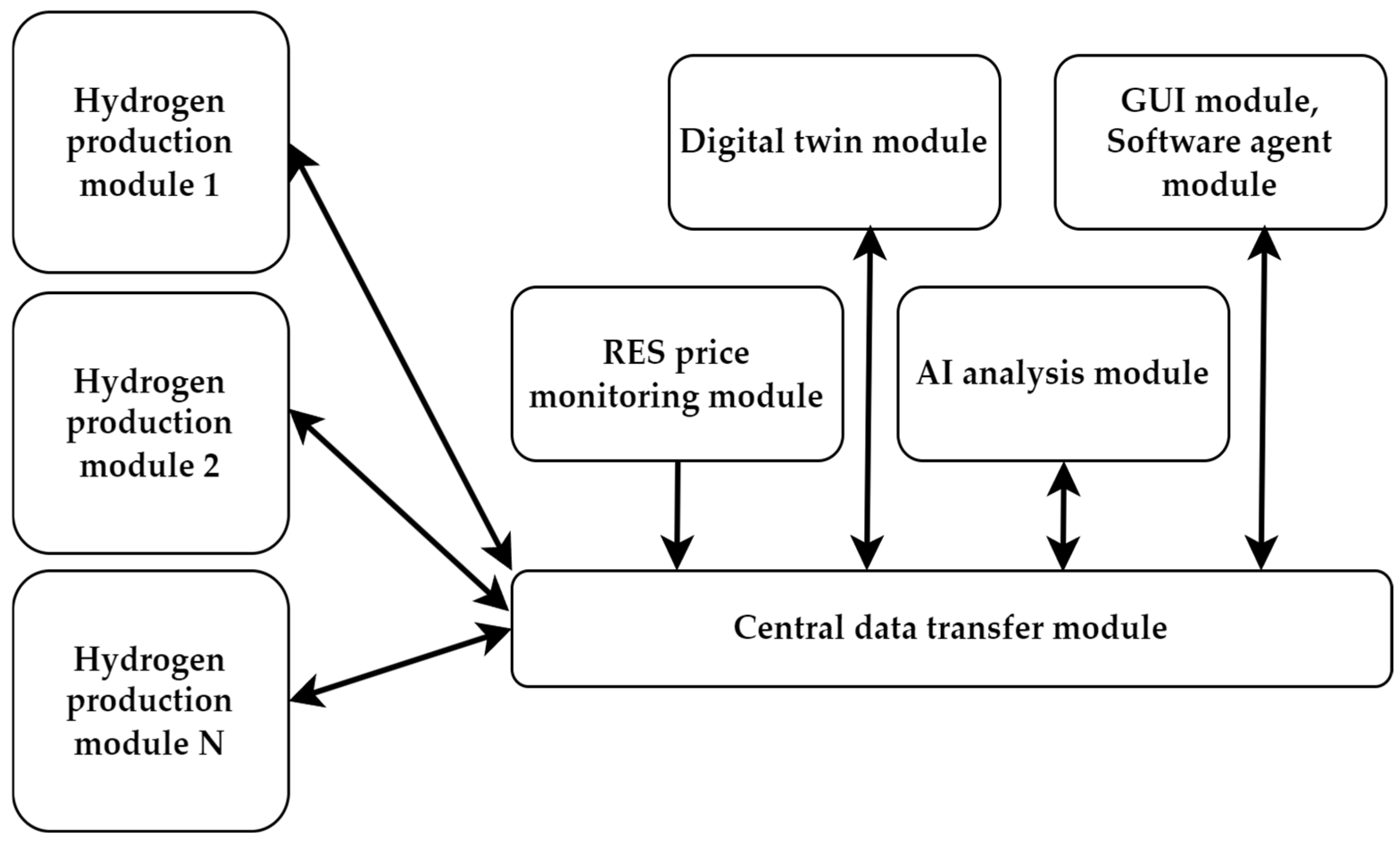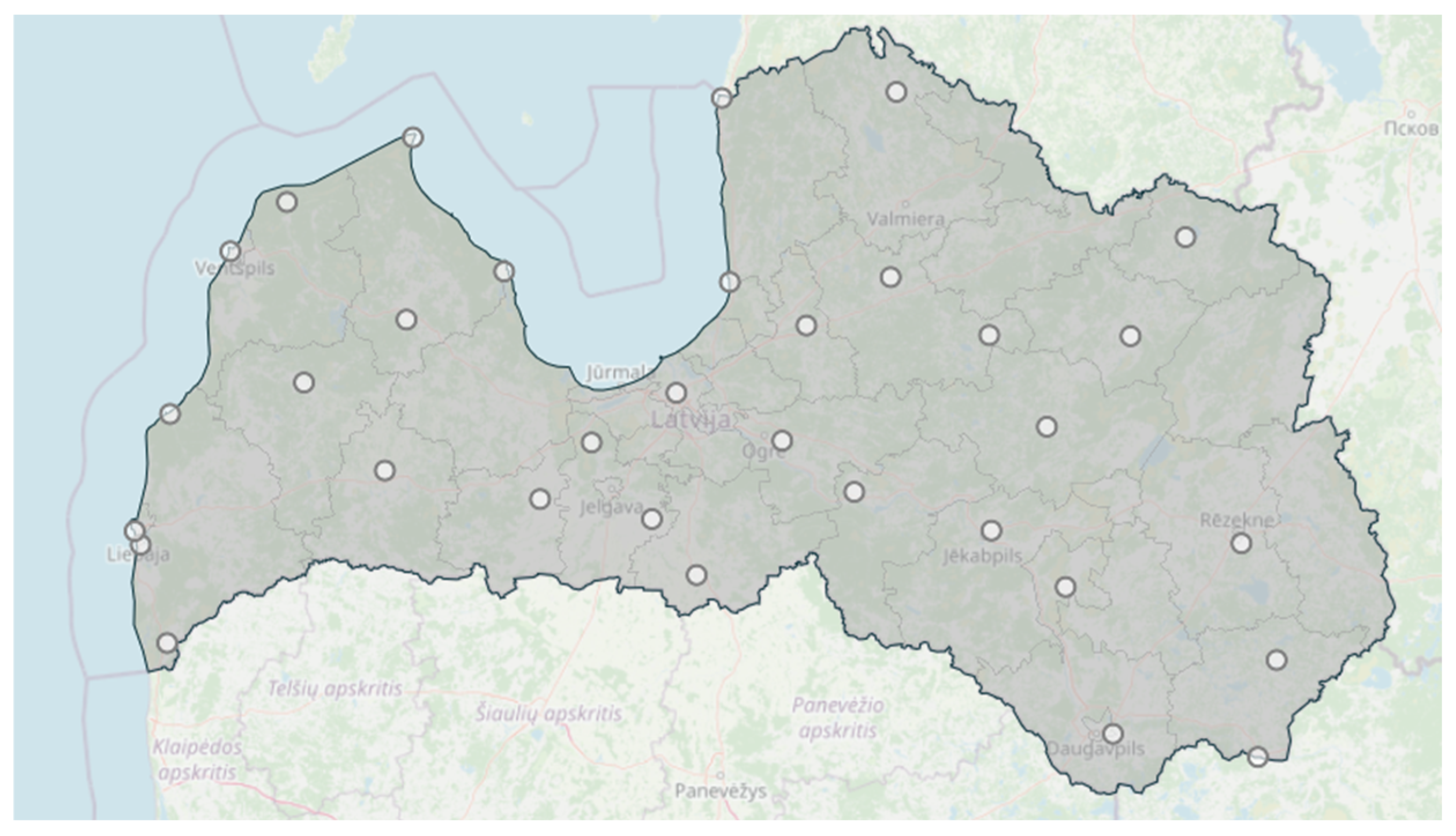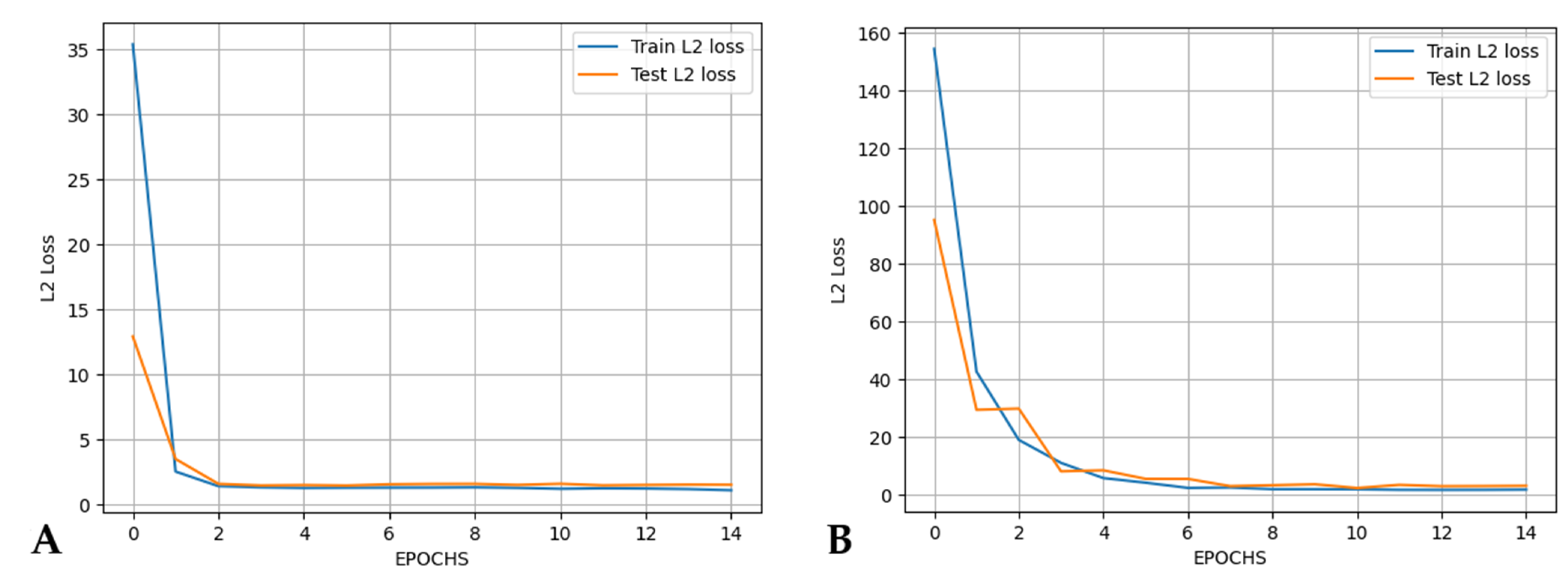Deep Learning for Wind and Solar Energy Forecasting in Hydrogen Production
Abstract
1. Introduction
1.1. State of the Art
1.2. Objectives of This Work
2. Materials and Methods
2.1. Communication Protocol
| Algorithm 1: Server and client Python scripts | |
| The script for the server side | The script for the client side |
| import zmq # create a ZeroMQ context context = zmq.Context() # set up a server socket server_socket = context.socket(zmq.REP) server_socket.bind(f”tcp://*:5555”) # receive the message on the server message = server_socket.recv() print (message) # send a reply from the server to the client server_socket.send(b”Hello, client!”) | import zmq # insert your computer ip serverIP = “192.0.2.X” # create a ZeroMQ context context = zmq.Context() # set up a client socket client_socket = context.socket(zmq.REQ) client_socket.connect(f”tcp://{serverIP}:5555”) # send a message from the client to the server client_socket.send(b”Hello, server!”) # receive the replay on the client reply = client_socket.recv() print (reply) |
2.2. Data
| Algorithm 2: Example of Python code for real-time data scraping to extract specific parameters (e.g., wind power) from a meteorological station in Latvia |
| import urllib.request url = “https://data.gov.lv/dati/api/3/action/datastore_search?resource_id=17460efb-ae99-4d1d-8144-1068f184b05f&limit=5” with urllib.request.urlopen(url) as response: html = response.read() print(html) |
2.3. AI Module
2.3.1. AI Module Based on an FCN
2.3.2. AI Module Based on a CNN
3. Results
4. Discussion
Author Contributions
Funding
Data Availability Statement
Conflicts of Interest
References
- OECD. World Energy Outlook 2023; World Energy Outlook; OECD: Paris, France, 2023; ISBN 978-92-64-64773-2. [Google Scholar]
- Carley, S.; Konisky, D.M. The Justice and Equity Implications of the Clean Energy Transition. Nat. Energy 2020, 5, 569–577. [Google Scholar] [CrossRef]
- Marouani, I.; Guesmi, T.; Alshammari, B.M.; Alqunun, K.; Alzamil, A.; Alturki, M.; Hadj Abdallah, H. Integration of Renewable-Energy-Based Green Hydrogen into the Energy Future. Processes 2023, 11, 2685. [Google Scholar] [CrossRef]
- Ahmadi, M.; Khashei, M. Current Status of Hybrid Structures in Wind Forecasting. Eng. Appl. Artif. Intell. 2021, 99, 104133. [Google Scholar] [CrossRef]
- Essam, Y.; Ahmed, A.N.; Ramli, R.; Chau, K.-W.; Idris Ibrahim, M.S.; Sherif, M.; Sefelnasr, A.; El-Shafie, A. Investigating Photovoltaic Solar Power Output Forecasting Using Machine Learning Algorithms. Eng. Appl. Comput. Fluid. Mech. 2022, 16, 2002–2034. [Google Scholar] [CrossRef]
- Runge, J.; Zmeureanu, R. A Review of Deep Learning Techniques for Forecasting Energy Use in Buildings. Energies 2021, 14, 608. [Google Scholar] [CrossRef]
- Jaramillo, M.; Pavón, W.; Jaramillo, L. Adaptive Forecasting in Energy Consumption: A Bibliometric Analysis and Review. Data 2024, 9, 13. [Google Scholar] [CrossRef]
- Chen, L.; Han, B.; Wang, X.; Zhao, J.; Yang, W.; Yang, Z. Machine Learning Methods in Weather and Climate Applications: A Survey. Appl. Sci. 2023, 13, 12019. [Google Scholar] [CrossRef]
- Sørensen, M.L.; Nystrup, P.; Bjerregård, M.B.; Møller, J.K.; Bacher, P.; Madsen, H. Recent Developments in Multivariate Wind and Solar Power Forecasting. WIREs Energy Environ. 2023, 12, e465. [Google Scholar] [CrossRef]
- Ghofrani, M.; Alolayan, M. Time Series and Renewable Energy Forecasting. In Time Series Analysis and Applications; Mohamudally, N., Ed.; InTech: Vienna, Austria, 2018; ISBN 978-953-51-3742-9. [Google Scholar]
- Alkhayat, G.; Hasan, S.H.; Mehmood, R. SENERGY: A Novel Deep Learning-Based Auto-Selective Approach and Tool for Solar Energy Forecasting; Mathematics & Computer Science: New York, NY, USA, 2022. [Google Scholar]
- Orwig, K.D.; Ahlstrom, M.L.; Banunarayanan, V.; Sharp, J.; Wilczak, J.M.; Freedman, J.; Haupt, S.E.; Cline, J.; Bartholomy, O.; Hamann, H.F.; et al. Recent Trends in Variable Generation Forecasting and Its Value to the Power System. IEEE Trans. Sustain. Energy 2015, 6, 924–933. [Google Scholar] [CrossRef]
- Manero, J.; Béjar, J.; Cortés, U. “Dust in the Wind...”, Deep Learning Application to Wind Energy Time Series Forecasting. Energies 2019, 12, 2385. [Google Scholar] [CrossRef]
- Li, Z.; Guo, P.; Han, R.; Sun, H. Current Status and Development Trend of Wind Power Generation-Based Hydrogen Production Technology. Energy Explor. Exploit. 2019, 37, 5–25. [Google Scholar] [CrossRef]
- Wang, H.; Xu, J.; Sheng, L.; Liu, X.; Lu, Y.; Li, W. A Review on Bio-Hydrogen Production Technology. Int. J. Energy Res. 2018, 42, 3442–3453. [Google Scholar] [CrossRef]
- Komasilovs, V.; Zacepins, A.; Kviesis, A.; Ozols, K.; Nikulins, A.; Sudars, K. Development of an MCTS Model for Hydrogen Production Optimisation. Processes 2023, 11, 1977. [Google Scholar] [CrossRef]
- Bosma, S.B.M.; Nazari, N. Estimating Solar and Wind Power Production Using Computer Vision Deep Learning Techniques on Weather Maps. Energy Tech. 2022, 10, 2200289. [Google Scholar] [CrossRef]
- Dumas, J.; Cointe, C.; Wehenkel, A.; Sutera, A.; Fettweis, X.; Cornelusse, B. A Probabilistic Forecast-Driven Strategy for a Risk-Aware Participation in the Capacity Firming Market. IEEE Trans. Sustain. Energy 2022, 13, 1234–1243. [Google Scholar] [CrossRef]
- Benti, N.E.; Chaka, M.D.; Semie, A.G. Forecasting Renewable Energy Generation with Machine Learning and Deep Learning: Current Advances and Future Prospects. Sustainability 2023, 15, 7087. [Google Scholar] [CrossRef]
- Brahma, B.; Wadhvani, R.; Shukla, S. Attention Mechanism for Developing Wind Speed and Solar Irradiance Forecasting Models. Wind. Eng. 2021, 45, 1422–1432. [Google Scholar] [CrossRef]
- Li, Y.; Wang, R.; Li, Y.; Zhang, M.; Long, C. Wind Power Forecasting Considering Data Privacy Protection: A Federated Deep Reinforcement Learning Approach. Appl. Energy 2023, 329, 120291. [Google Scholar] [CrossRef]
- Ahmadi, A.; Talaei, M.; Sadipour, M.; Amani, A.M.; Jalili, M. Deep Federated Learning-Based Privacy-Preserving Wind Power Forecasting. IEEE Access 2023, 11, 39521–39530. [Google Scholar] [CrossRef]
- Aslam, S.; Herodotou, H.; Mohsin, S.M.; Javaid, N.; Ashraf, N.; Aslam, S. A Survey on Deep Learning Methods for Power Load and Renewable Energy Forecasting in Smart Microgrids. Renew. Sustain. Energy Rev. 2021, 144, 110992. [Google Scholar] [CrossRef]
- De Castro, J.G.K.; Carvalho, B.F.; De Melo, N.S.; De Souza Figueiredo, P.T.; Moreira-Mesquita, C.R.; De Faria Vasconcelos, K.; Jacobs, R.; Leite, A.F. A New Cone-Beam Computed Tomography–Driven Index for Osteoporosis Prediction. Clin. Oral. Investig. 2020, 24, 3193–3202. [Google Scholar] [CrossRef]
- Goncalves, C.; Bessa, R.J.; Pinson, P. Privacy-Preserving Distributed Learning for Renewable Energy Forecasting. IEEE Trans. Sustain. Energy 2021, 12, 1777–1787. [Google Scholar] [CrossRef]
- Park, S.; Kim, Y.; Ferrier, N.J.; Collis, S.M.; Sankaran, R.; Beckman, P.H. Prediction of Solar Irradiance and Photovoltaic Solar Energy Product Based on Cloud Coverage Estimation Using Machine Learning Methods. Atmosphere 2021, 12, 395. [Google Scholar] [CrossRef]
- ZeroMQ. Available online: https://zeromq.org/ (accessed on 29 January 2024).
- Latvijas Atvērto Datu Portāls. Available online: https://data.gov.lv/lv (accessed on 29 January 2024).
- Latvijas Vides, Ģeoloģijas Un Meteoroloģijas Centrs. Available online: https://videscentrs.lv (accessed on 29 January 2024).
- Hosseinzadeh, M.; Salmasi, F.R. Robust Optimal Power Management System for a Hybrid AC/DC Micro-Grid. IEEE Trans. Sustain. Energy 2015, 6, 675–687. [Google Scholar] [CrossRef]
- Zhang, Y.; Lin, F.; Wang, K. Robustness of Short-Term Wind Power Forecasting against False Data Injection Attacks. Energies 2020, 13, 3780. [Google Scholar] [CrossRef]
- Majumder, I.; Bisoi, R.; Nayak, N.; Hannoon, N. Solar Power Forecasting Using Robust Kernel Extreme Learning Machine and Decomposition Methods. IJPEC 2020, 11, 260. [Google Scholar] [CrossRef]
- Li, W.; Pan, B.; Xia, J.; Duan, Q. Convolutional Neural Network-Based Statistical Post-Processing of Ensemble Precipitation Forecasts. J. Hydrol. 2022, 605, 127301. [Google Scholar] [CrossRef]
- Kareem, S.; Hamad, Z.J.; Askar, S. An Evaluation of CNN and ANN in Prediction Weather Forecasting: A Review. Sustain. Eng. Innov. 2021, 3, 148–159. [Google Scholar] [CrossRef]
- Kuzle, I.; Đaković, J.; Franc, B.; Liu, Y. Deep Neural Network Configuration Sensitivity Analysis in Wind Power Forecasting. JOE 2022, 70, 19–24. [Google Scholar] [CrossRef]




| Parameter Code | Description |
|---|---|
| HPRAB | Precipitation amount, hourly sum, mm |
| HWDMX | Wind direction, hourly maximum speed, 0–360 degrees |
| HWSMX | Wind speed, hourly maximum, m/s |
| PRSS | Atmospheric pressure at station level, actual QFE, hPa |
| RLH | Relative humidity, actual, % |
| SNOWA | Snow depth, actual, cm |
| TDRY | Air temperature actual, Celsius degrees |
| VSBA | Visibility meteorological, actual, m |
| WNDD10 | Wind direction, actual, 0–360 degrees |
| WNS10 | Wind speed, actual, m/s |
| Layer (Type) | Output Shape | Param Count |
|---|---|---|
| Input | [−1, 1, 6000] | 0 |
| Linear-1 | [−1, 1, 500] | 3,000,500 |
| Linear-2 | [−1, 1, 500] | 250,500 |
| Linear-3 | [−1, 1, 500] | 250,500 |
| Linear-4 | [−1, 1, 500] | 250,500 |
| Linear-5 | [−1, 1, 1] | 501 |
| Layer (Type) | Output Shape | Param Count |
|---|---|---|
| Input | [−1, 1, 6000] | 0 |
| Conv1d-1 | [−1, 500, 1999] | 3000 |
| MaxPool1d-2 | [−1, 500, 999] | 0 |
| Conv1d-3 | [−1, 500, 332] | 1,250,500 |
| MaxPool1d-4 | [−1, 500, 166] | 0 |
| Conv1d-5 | [−1, 500, 81] | 1,250,500 |
| MaxPool1d-6 | [−1, 500, 40] | 0 |
| Conv1d-7 | [−1, 500, 18] | 1,250,500 |
| MaxPool1d-8 | [−1, 500, 17] | 0 |
| Conv1d-9 | [−1, 500, 7] | 1,250,500 |
| MaxPool1d-10 | [−1, 500, 6] | 0 |
| Flatten-11 | [−1, 3000] | 0 |
| Linear-12 | [−1, 500] | 1,500,500 |
| Linear-13 | [−1, 1] | 501 |
| T = 0 s; 25 kW; +0 kW −0 kW; 100% certain |
| T = 600 s; 21 kW; +1 kW −1 kW; 95% certain |
| T = 1200 s; 18 kW; +3 kW −1 kW; 92% certain |
| T = 1800 s; 11 kW; +1 kW −1 kW; 84% certain |
| T = 2700 s; 2 kW; +0 kW −2 kW; 60% certain |
| T = 3600 s; 22 kW; +2 kW −1 kW; 90% certain |
Disclaimer/Publisher’s Note: The statements, opinions and data contained in all publications are solely those of the individual author(s) and contributor(s) and not of MDPI and/or the editor(s). MDPI and/or the editor(s) disclaim responsibility for any injury to people or property resulting from any ideas, methods, instructions or products referred to in the content. |
© 2024 by the authors. Licensee MDPI, Basel, Switzerland. This article is an open access article distributed under the terms and conditions of the Creative Commons Attribution (CC BY) license (https://creativecommons.org/licenses/by/4.0/).
Share and Cite
Nikulins, A.; Sudars, K.; Edelmers, E.; Namatevs, I.; Ozols, K.; Komasilovs, V.; Zacepins, A.; Kviesis, A.; Reinhardt, A. Deep Learning for Wind and Solar Energy Forecasting in Hydrogen Production. Energies 2024, 17, 1053. https://doi.org/10.3390/en17051053
Nikulins A, Sudars K, Edelmers E, Namatevs I, Ozols K, Komasilovs V, Zacepins A, Kviesis A, Reinhardt A. Deep Learning for Wind and Solar Energy Forecasting in Hydrogen Production. Energies. 2024; 17(5):1053. https://doi.org/10.3390/en17051053
Chicago/Turabian StyleNikulins, Arturs, Kaspars Sudars, Edgars Edelmers, Ivars Namatevs, Kaspars Ozols, Vitalijs Komasilovs, Aleksejs Zacepins, Armands Kviesis, and Andreas Reinhardt. 2024. "Deep Learning for Wind and Solar Energy Forecasting in Hydrogen Production" Energies 17, no. 5: 1053. https://doi.org/10.3390/en17051053
APA StyleNikulins, A., Sudars, K., Edelmers, E., Namatevs, I., Ozols, K., Komasilovs, V., Zacepins, A., Kviesis, A., & Reinhardt, A. (2024). Deep Learning for Wind and Solar Energy Forecasting in Hydrogen Production. Energies, 17(5), 1053. https://doi.org/10.3390/en17051053









